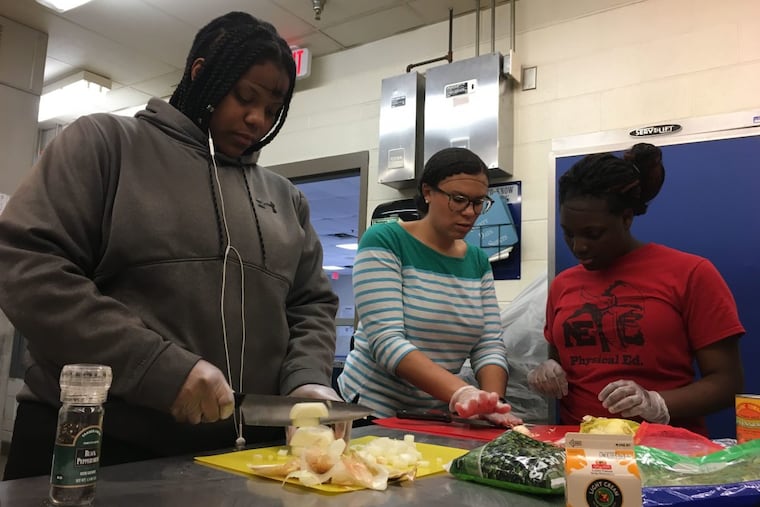Trying new foods, and learning lessons along the way
The mission of My Daughter's Kitchen cooking program is to introduce students to inexpensive, healthy and easy meals that they can prepare for themselves.

While looking over the recipe for after-school cooking class, student Destiny Crawford, 17, noticed the nutritional information and posed a question: "What are calories anyway, and what's the big deal about them?"
Delaney Taylor, the volunteer teacher, is a senior at the University of Pennsylvania studying health and societies, and was beautifully prepared to answer, with an explanation of calories as energy units, along with an estimation of how many calories your body needs each day based on activity level, and how this recipe with 477 calories compares to a fast-food meal that might have twice that. It's also important to make sure there are nutrients in the calories consumed, not empty calories, she explained.
Destiny, a junior at Kensington Health and Sciences Academy, got it immediately. "Do you know that we did a survey in this school and more than half of the students stop at the corner store for snacks three to five days a week?" she said. "You can get two bags of chips, a soda, and a brownie for five bucks," she said. "It is enough to fill you up."
Did anything change after the survey was done?
"Nah. No one would listen, anyway," Destiny said. "People want their snacks."
And therein lies the challenge of transforming the eating habits of American teenagers. The mission of My Daughter's Kitchen cooking program is to do just that, by introducing students to inexpensive, healthy, and easy meals they can prepare for themselves. Kensington Health and Sciences is one of 35 cooking classes in the program, being taught by volunteers at urban schools in Camden and Philadelphia this spring.
Chicken tikka masala, an Indian dish, was the lesson this week, and few students at the schools around the region were familiar with the dish, or with Indian food in general.
Some, like the students at McClure Elementary in North Philadelphia, were excited to try a dish they had never heard of, but others were not intrigued by the idea of chicken marinated in yogurt and seasoned in spices including cayenne, paprika, cumin, fresh ginger, and an Indian spice blend called garam masala.
"I'm not going to eat this," said Jasmine Mitchell, 19, a senior at Kensington, who professed a hatred for ginger and peas, also in the dish.
She was told to keep an open mind.
At Kensington Health and Sciences, a few of the students have already made for their families recipes they learned in class. "My family keeps asking me when I am going to make it again," said Destiny, who made the cornflake chicken at home.
Delaney, the Penn student teaching the Kensington class, got connected to the program while working as an intern for Vetri Community Partnership, which administers the My Daughter's Kitchen program. She is writing a final paper on what she's witnessed. "If they take it to heart," she said, "they can see how easy it is to cook themselves."
Increasing access to healthy food is one of the priorities at Kensington Health and Sciences, and this cooking class "directly addresses that need, and increases the students' ability to extend that into their own home," said Antonio Romero, community schools coordinator there.
But he also sees other benefits, like reaching kids who wouldn't ordinarily stay after for an activity. "Not everyone is athletic," he said. "If they like this, they may stay after for something else. … If they try new things in one area, they may be willing to try other new things." He also sees kids from different circles getting to know one another. And it's another opportunity for students to see that adults care about them.
This week's recipe with all the different spices, the marinating, the timing, the chopping, the sautéing, made it the most complicated in this, the sixth week of cooking class. And volunteers across the region reported that it challenged the young cooks.
"We learned the recipes are like road maps," wrote Maria Brown, a volunteer at Visitation of the Blessed Virgin Mary School in Kensington. "You have to read them carefully and precisely to get where you want to go. There is no GPS to assist!"
Yet there were also rewards. Students at Wiggins Elementary in Camden witnessed the allure of the chicken's flavorful aroma as it was being sautéed, as many visitors were drawn into the kitchen just to see what was cooking, teacher Edith Bobb reported. "Since it smells so good, it's going to have to taste good," Wiggins student Daniel Davis said.
At Kensington, after the chicken was finished and served over brown rice, the students invited Romero, the school coordinator, to join them for dinner. He was happy to accept.
The students immediately recognized a familiar flavor: "It tastes like halal," said Destiny, referring to the food trucks that sell halal-prepared chicken.
"Why do you think it tastes like halal?" said Romero, inserting a lesson. "What religion prays over halal food?" he asked.
Islam, the students answered.
And Islam is based in the Middle East and Arabian Peninsula, which is near India, he said, so the culture and spices overlap.
As they were discussing this, Jasmine, who had insisted she hated ginger and peas and was not going to eat the dish, was enjoying it without hesitation. She finished every last bite, peas and all.
"It was good," she conceded. And she packed up some leftovers to take home.